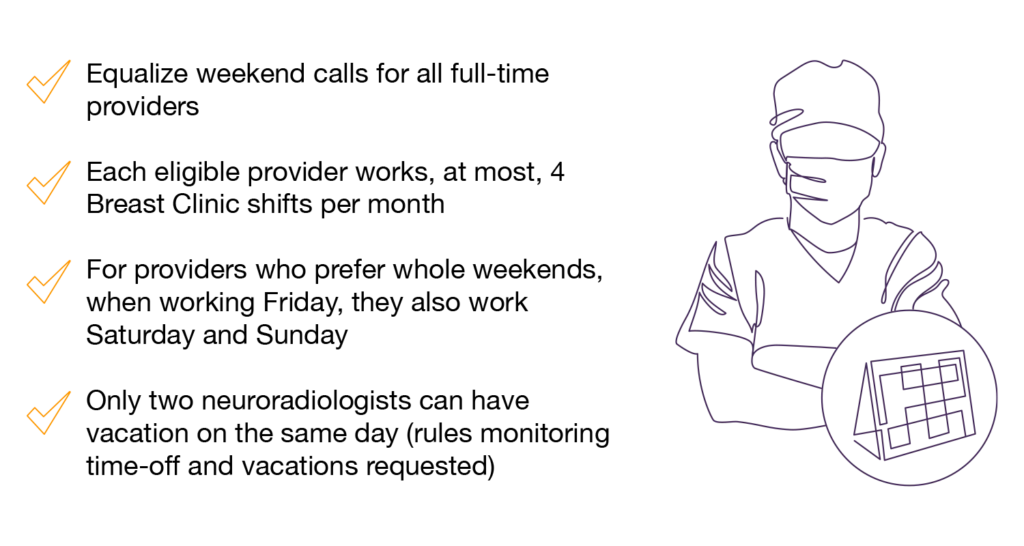Live Event
Real solutions from experts who've moved the needle on burnout
Register NowTABLE OF CONTENTS

The workload of US radiologists has increased over the past two decades.1 However, the number of new radiologists entering the field hasn’t grown to match demand. This shortage, combined with increasing demand for imaging services, has drawn radiologist productivity measurement and management back into the spotlight.
In this blog, we’ll examine why standard productivity tools like relative value units (RVUs) miss the mark for radiology services, and how a digital provider scheduling solution can supplement RVUs to improve measurement while enhancing radiology productivity.
In medicine, RVUs are a measure of productivity frequently used to “support the calculation of physician reimbursements.” Many radiology practices and departments use RVUs for this purpose, but this system has known limitations.2 The RVU concept was first conceived by a Harvard economics professor in the 1980s,3 and over time, they’ve become instrumental in defining physician compensation.
RVUs are ideal for calculating and benchmarking patient revenue generated per radiologist, per imaging study, per specialty/modality, or per facility. However, focusing too intently on RVU production may result in leaders under-appreciating the holistic value generated by radiologists and imaging staff. Because of this, overdependence on RVUs to define radiologist salaries can result in unfair and imbalanced physician pay. RVUs also present a number of other challenges:
Because RVUs fail to provide insight into all of the work providers are doing, and unless your team equally distributes holidays, weekends, and other shifts, RVUs can’t reliably measure radiologist productivity.
To make a long story short, RVU metrics don’t accurately tell us how much work physicians are doing. Using the logic that underpins RVUs, any time a physician is not “producing,” it’s considered “wasted time.”
Automated scheduling with robust analytics capabilities can both create an optimized radiologist schedule and generate a clearer image of radiology production. The first step is to gain better insight into the true productivity of your providers to more deeply understand how the RVUs are being applied. Below are some ways that automated scheduling can reveal the true productivity of providers and equipment in your practice.
Automated scheduling rules enable more balanced and equitable radiologist scheduling across favorable and unfavorable, high and low demand, and on-call shifts. For example, if one provider is consistently working unfavorable, low-demand shifts (meaning fewer revenue-generating opportunities) while another provider is repetitively scheduled for their favorite shift, the providers’ productivity levels will most likely not match. Distributing the workload more evenly gives physicians the best chance at balancing job satisfaction, personal wellness, and productivity.
Automated scheduling helps optimize department production by ensuring imaging equipment is scheduled to capacity to aid resource allocation and utilization. For example, many clients use PerfectServe’s Lightning Bolt Scheduling to track exam room and OR utilization. The same can be done for imaging equipment by assigning radiologists and radiology technologists to specific equipment to identify inefficiencies and opportunities to increase revenue. By scheduling providers with certain equipment and rooms, you can see which equipment may be underutilized and when. Capitalize on those opportunities by scheduling additional providers at specific times. Alternatively, you can see when equipment is in high demand and schedule faster readers during peak times to increase capacity.
Automated scheduling appropriately tags hours or shifts that may not be revenue-generating or related to direct patient care. For example, tag shifts for specialty imaging like neurology, breast imaging, pediatrics, and ultrasound. Plus, tag shifts for non-clinical time, including administrative work, continuing education, teaching, and research. Tagged shifts reflect the type of work providers are doing, so you can generate granular reports about their type of work, when they are scheduled, and where each shift takes place. This capability further tracks what type of imaging a provider is doing and can be better analyzed for RVU scoring.
Automated scheduling also tags hours or shifts according to specialty, modality, and location, which creates a better framework for apples-to-apples productivity comparisons. This tagging of shifts helps track productivity across specialties and shift types for a deeper understanding of which providers may need more support than others.
An advanced, rule-based scheduling solution can be implemented to automatically distribute your shifts evenly. You can create rules that ensure providers are scheduled fairly and equitably across subspecialties and locations, all while accounting for their individual preferences. With these rules in place, the solution then auto-generates an optimized schedule. Examples of common rules include:

An advanced scheduling solution can build better schedules for your organization while uncovering more useful insights about your operations. Save time by streamlining complicated scheduling processes, and gain access to advanced workforce analytics that demonstrate actual value versus perceived value. You can also maximize provider productivity and equipment utilization by gaining clear insight into when your resources are—or are not—being used efficiently.
To learn more about the impact scheduling can have on radiology productivity, contact us today or schedule a demo below.
Sources:
1 Radiologists’ Variation of Time to Read Across Different Procedure Types, Society of Imaging Informatics in Medicine, Journal of Digital Imaging: https://doi.org/10.1007/s10278-016-9911-z
2 Leveraging the electronic health record to evaluate the validity of the current RVU system for radiologists, Clinical Imaging, 2021: doi.org/10.1016/j.clinimag.2021.02.007
3 This one metric can make or break any doctor’s career, MDLinx: https://www.mdlinx.com/article/this-one-metric-can-make-or-break-any-doctors-career/4NJBhvd5GiKbKxn51tPn9e